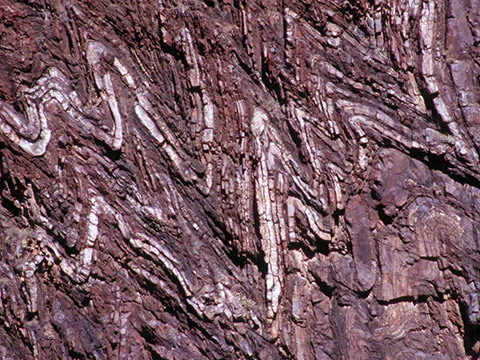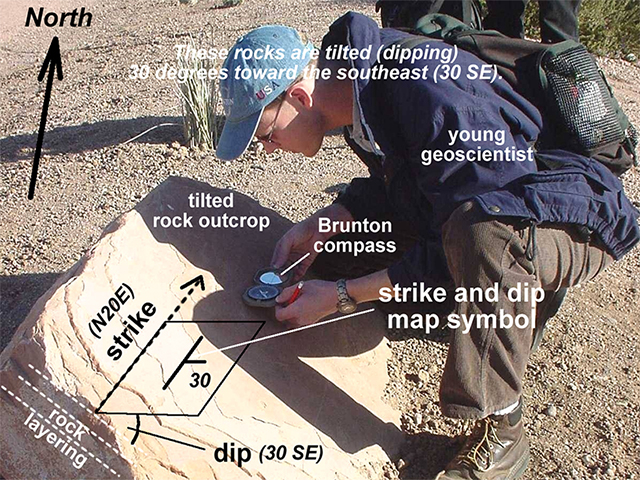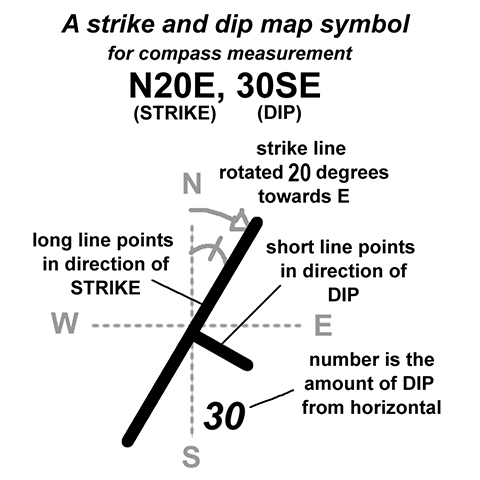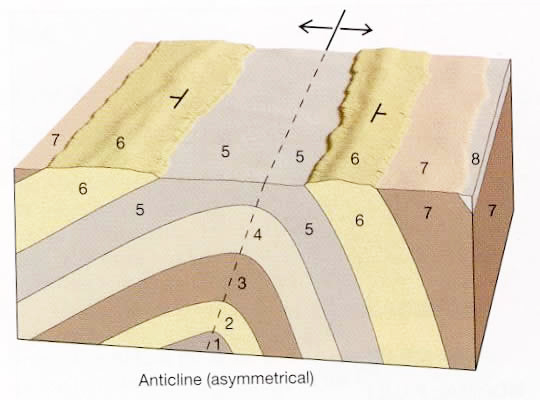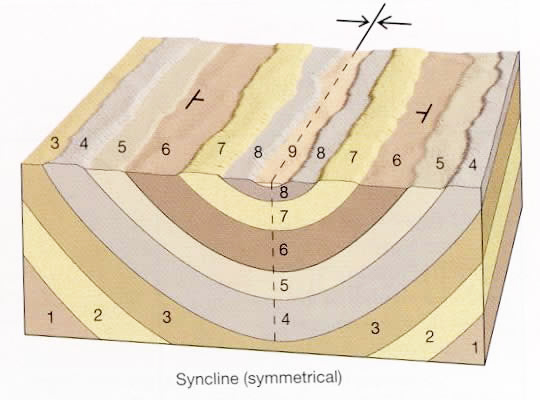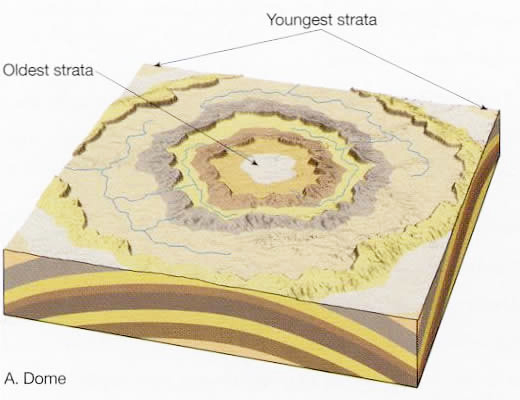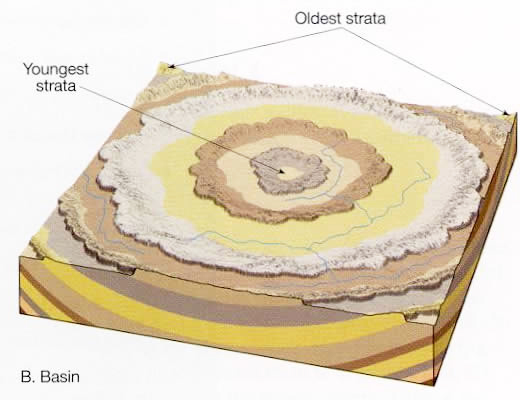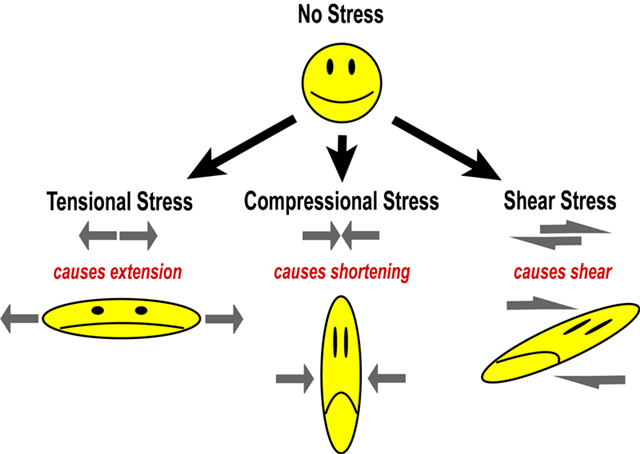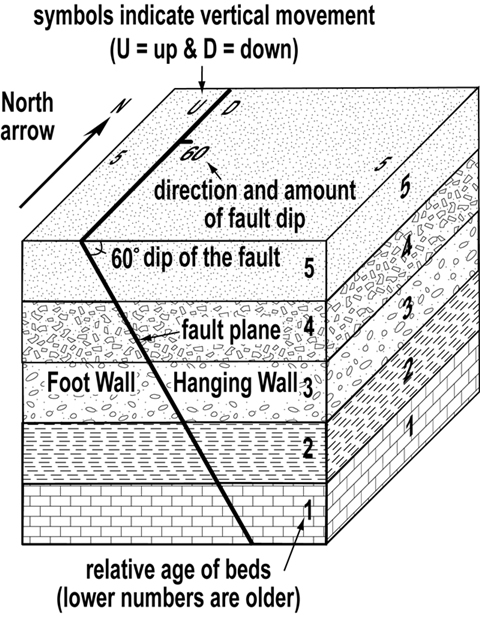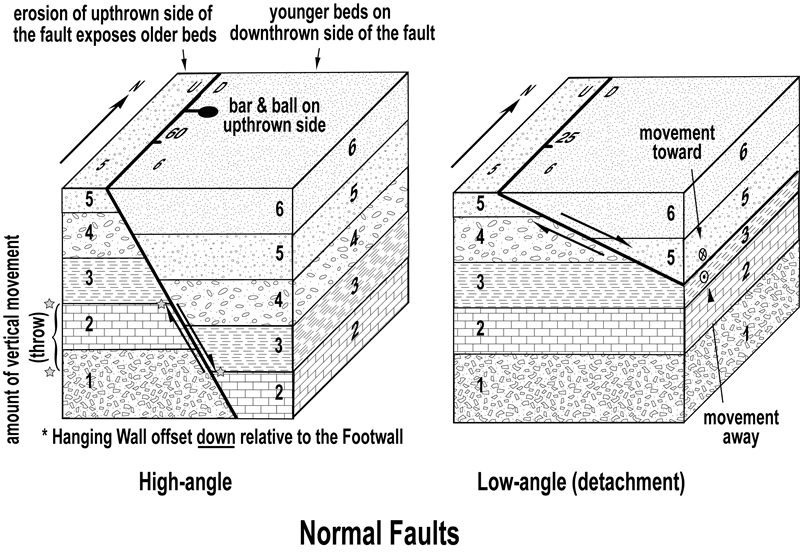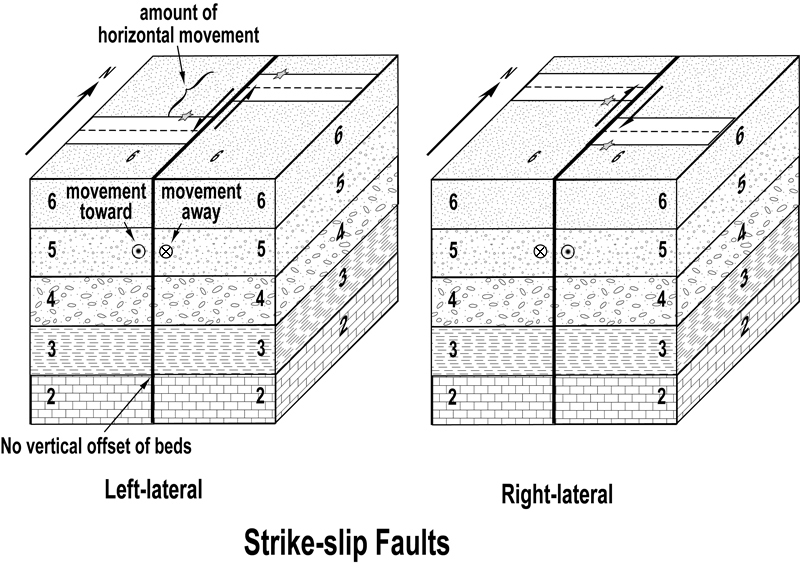Part B
Geologic Structures
Geologic structures are features, like folds, faults, and fractures, that represent some type of disturbance or deformational event that affected the rock layers.
|
Figure 7-5. Folds and faults of central Arizona. Early Proterozoic chevron folds exposed in the north wall of Barnhardt Canyon (left). |
|
Strike & Dip
Before you can interpret the tectonic events of the past, you need to be able describe the orientation of rock layers. You may encounter a rock outcrop like the one in Figure 7-6. We can use the concept of strike and dip to describe and interpret the orientation of these rock units in three dimensions. Let's see how a geologist describes the orientation of these layers.
|
|
|
|
Figure 7-6. The concept of strike and dip illustrated on a series of tilted rocks. Shane measures the strike and dip of tilted rocks in the field (left). A strike and dip map symbol for Shane's measurement (right). |
|
Let's describe the strike and dip of the layers shown in Figure 7-6:
1) Where is north?
> The first step is to determine which direction is north, and consequently, northeast, southeast, northwest, and southwest. North is typically toward the top of the page or screen, unless otherwise indicated. North direction is shown in Figure 7-6.
2) Which direction are the layers dipping?
> The direction the layers are tilted is the dip direction. This will be either northeast (NE), southeast (SE), northwest (NW), or southwest (SW). In this case, it's southeast (SE).
3) Visualize the dip and strike directions with your hand
> Before you begin measuring strike and dip with the compass, you can visualize strike and dip with your hands. On one hand, simply make your thumb and index finger at right angles. Point your thumb in the direction the layers are dipping (that's the dip direction). Your index finger will be pointing in the strike direction. Easy! All you will be doing with the compass is quantifying your hand measurement.
4) What is the amount of dip (tilt) of the layers?
> Now we measure the amount of tilt (dip), from 0 to 90°. Flat-lying (horizontal) layers are not tilted, so they have a dip of 0°; vertical layers have the maximum dip of 90°. In this case, the layers have a 30° dip.
5) Put dip direction and dip amount together
> A typical dip measurement includes both the direction and amount of dip. Put together with the dip direction, the dip is 30 degrees toward the southeast or 30 SE.
6) What is the strike direction?
> Once the dip direction is known, strike is easily measured. Strike is the compass direction of the trend of the layers at the Earth's surface. This direction is always perpendicular (at right angles) to the dip direction. Because strike is a compass direction, it is usually expressed relative to north, like "north X degrees east," or "north X degrees west." Here, the strike is to the northeast (specifically, about north 20 degrees east or N20E).
7) Put strike and dip together
> A strike and dip measurement is written with the strike first, then the dip. In our example, it is: N20E, 30 SE.
|
Example 1 |
|
|
|
Describe the orientation of a map unit having this strike and dip symbol. |
|
The strike of the unit is to the NE, the dip of this unit is to the SE at 22° (the long strike line points toward the NE and the short dip line points to the SE with the value of 22°) |
|
Example 2 |
|
|
|
Which one of these strike and dip symbols would be the correct one for a map unit that dips to the northwest at 60° (60 NW)? |
|
C (the short dip line points to the NW) |
Identifying Geologic Structures - Folds
Folds form in rock layers as they are slowly squeezed by COMPRESSIONAL stresses. These stresses are a result of mountain-building processes (like in the Appalachians, Himalayas, etc.) that typically occur where tectonic plates collide.As shown in Figure 7-7, folds are seen easily in a geologic cross section (side view), but they also can be identified on a map view (top view) of the Earth's surface, as represented by a geologic map. GEOLOGIC BLOCK DIAGRAMS combine these views into one model (see Fig. 7-8).
We classify and interpret different folds based on their shapes, rock layer ages, etc. Each fold consists of two limbs divided by an axial plane, and the type of fold is determined by the direction the limbs are dipping relative to the axial plane (see Figure 7-8).
|
Figure 7-7. A syncline exposed in a roadcut in St. George Utah, which represents a "real life" geologic cross section.Click on the image to see an annotated version. |
|
|
|
Figure 7-8. A block diagram of anticline and syncline folds. The numbers represent the relative ages of the map units (lower numbers are older). The pattern fill represents the composition of the map units. Strike and dip symbols represent the orientation of the map units. |
In Geologic Cross Sections
Road cuts, stream canyons, etc. represent real geologic cross sections. It's almost like having the answer key!
> Folds can be easily identified based on their shape.
> Each FOLD consists of limbs (sides) divided by an AXIAL PLANE (an imaginary plane that divides the fold in half at the point of maximum curvature). Axial plane orientations range from vertical to steeply dipping (laying down).
> The TYPE OF FOLD is determined by both the direction (toward or away from) the limbs are dipping relative to the axial plane and the orientation of the axial plane (upright, inclined, recumbent, overturned).
In Geologic Map View
Geologic map views represent the situation we typically have when there are limited vertical exposures. Still, we can use certain clues to identify and describe fold structures.
> Look for REPEATING layers. The center of the fold in map view is simply the middle of a repeating sequence of layers.
> The axial trace follows the trend of the center of the fold, and may include a geologic structure symbol that labels the type of fold.
> Look at the relative ages of the layers to help determine the type of fold.
> Look at the dip of the layers to help determine the type of fold.
> Sometimes curving outcrop patterns are created by PLUNGING FOLDS, where the fold itself is tilted.
Anticlines & Synclines
Anticlines and synclines are the most basic of fold types. Each has a distinctive shape in cross section, however, they typically look similar in geologic map view. We need more information (like unit strike and dip, rock composition, and age) to discriminate between anticlines and synclines in geologic map view.
In geologic cross section view:
> The fold limbs dip away from the center of the fold (axial plane).
> The fold points upward and forms the shape of an "A".
In geologic map view:
> As represented by the strike and dip symbols, the layers dip away from the center of the fold (axial trace).
> The OLDEST rock unit is in the center of the fold (lowest age numbers), and the layers are progressively younger on either side of the axial trace (young-old-young).
> An anticline's STRUCTURE SYMBOL is located along the center of the fold, and has the arrows pointing away from the axial trace because the fold limb dips away from the axial trace.
|
|
|
Figure 7-9. A block diagram of an anticline. The numbers represent the relative ages of the map units (lower numbers are older). Strike and dip symbols represent the orientation of the map units. Notice how non-plunging folds like this one (and the one in 7-10) have straight, symmetrical outcrop patterns. |
In geologic cross section view:
> The fold limbs dip toward the center of the fold (axial plane).
> The fold points downward and forms the shape of a "U" or "V".
In geologic map view:
> As represented by the strike and dip symbols, the layers dip toward the center of the fold (axial trace).
> The YOUNGEST rock unit is in the center of the fold (highest age numbers), and the layers are progressively older on either side of the axial trace (old-young-old).
> A syncline's STRUCTURE SYMBOL is located along the center of the fold, and has the arrows pointing toward the axial trace because the fold limb dips toward the axial trace.
|
|
|
Figure 7-10. A block diagram of a syncline. The numbers represent the relative ages of the map units (lower numbers are older). Strike and dip symbols represent the orientation of the map units. |
Structural Domes & Basins
Domes and basins are very similar to anticlines and synclines, respectively.
In geologic cross section view:
> The layers bend/point upward, forming a shape like that of a broad anticline.
> As with anticlines, the layers tilt (dip) away from the center of the fold.
> You can't really distinguish an anticline from a dome in cross section.
In geologic map view:
> Domes have circular ("bulls-eye"-shaped) map patterns.
> The general dip of the layers in domes resemble those of anticlines, with the layers dipping away from the center in all directions.
> The OLDEST rock unit is in the center of the fold (lowest age numbers), and layers are progressively younger away from the center.
> A dome's STRUCTURE SYMBOL is located in the center of the fold, and has the arrows pointing away from the center.
> Thus, domes are essentially circular anticlines.
|
|
|
Figure 7-11. A block diagram of a structural dome. The numbers represent the relative ages of the map units (lower numbers are older). Strike and dip symbols represent the orientation of the map units. |
In geologic cross section view:
> The layers bend/point downward, forming a shape like that of a broad syncline.
> As with synclines, the layers tilt (dip) toward the center of the fold.
> You can't really distinguish a syncline from a basin in cross section.
In geologic map view:
> Basins have circular ("bulls-eye"-shaped) map patterns (just like domes).
> The general dip of the layers in basins resemble those of synclines, with the layers dipping toward the center from all directions.
> The age relationships of the layers in basins resemble those of synclines, with the YOUNGEST rock unit in the center of the basin (highest age numbers), and layers are progressively older away from the center.
> A basin's STRUCTURE SYMBOL is located in the center of the fold, and has the arrows pointing toward the center.
> Thus, basins are essentially circular synclines.
|
|
|
Figure 7-12. A block diagram of a structural basin. The numbers represent the relative ages of the map units (lower numbers are older). Strike and dip symbols represent the orientation of the map units. |
![]()
![]()
![]()
![]()
![]()
![]()
![]()
![]()
![]()
![]()
Identifying Geologic Structures - Faults
Faults are formed as various kinds of tectonic stress cause brittle crustal rocks to fracture and move. Some faults involve large amounts of offset (hundreds of kilometers), like the San Andreas transform fault, whereas others can be microscopic in scale.
|
Figure 7-13. Faulted Paleoproterozoic quartz vein in the Crazy Basin area of the Bradshaw Mountains. |
Types of Stress
The main types of stress (a force applied over a certain area) include tension (pulling apart or lengthening), compression (squeezing or shortening), and shear (smearing or tearing in a horizontal motion). These stresses are shown in Figure 7-14. The type of applied stress determines the type of fault that is produced, with each type of stress forming a different type of fault.
|
|
|
Figure 7-14.Types of stress. |
Types of Faults
Faults are classified based on the orientation of the fault plane and the direction offset along the fault. There are two main types of faults, depending on whether movement along the fault is vertical (a dip-slip fault) or horizontal (a strike-slip fault). In many instances, two types of stress (like compression and shear) can combine to form an oblique-slip fault, which has some amount of both vertical and horizontal motion.
Dip-slip Faults
Dip-slip faults (see Figure 7-15) have two parts: a hanging wall above the fault plane, and a foot wall below the fault plane. The relative movement of the hanging wall with respect to the footwall is used to determine whether the dip-slip fault is normal or reverse (see Figure 7-16). This is easiest to see in a geologic cross section.
To identify a whether a dip-slip fault is normal or reverse:
> Determine which side of the fault is the hanging wall.
> Determine which way the hanging wall moved relative to the footwall. Draw an arrow showing the direction of movement of the hanging wall.
> Use the definition to name the dip-slip fault:
hanging wall up = reverse fault
hanging wall down = normal fault
|
|
|
Figure 7-15. Fault terminology for dip-slip faults. |
NORMAL FAULTS
> A normal fault is a dip-slip fault where the hangingwall block moves down relative to the footwall block.
> Low-angle (<30 degree dip) normal faults are also called detachment faults.
> Normal faults are caused by tensional stresses.
REVERSE FAULTS
> A reverse faults is a dip-slip fault where the hangingwall block moves up relative to the footwall block.
> Low-angle (<30 degree dip) reverse faults are also called thrust faults.
> Reverse faults are caused by compressional stresses.
|
|
|
|
|
Figure 7-16. Normal and reverse dip-slip faults. |
Strike-slip faults
> Vertical to nearly vertical faults (no real hanging wall or foot wall) having mainly horizontal motion.
> Defined by the direction of horizontal offset between opposing sides of the fault.
right-lateral strike-slip fault - The opposite side of the fault is offset to the RIGHT.
left-lateral strike-slip fault - The opposite side of the fault is offset to the LEFT.
> Large strike-slip faults that occur at tectonic plate boundaries are referred to as transform faults.
> Strike-slip faults are caused by shear stresses.
|
|
|
Figure 7-17. Strike-slip faults. |
![]()
![]()
![]()
![]()
![]()
